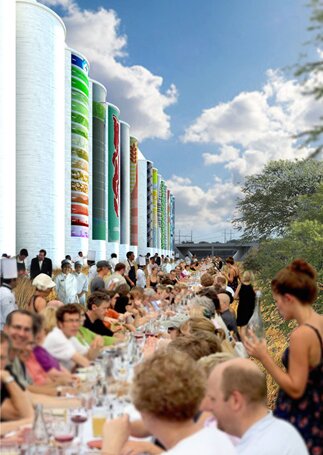‘concre(A)te synergies’ by Brian Kelly
August 30th, 2010 : : Anne : : Tag Words: Banner, Stored Potential 1With the silos positioned prominently in the middle of Omaha along Interstate 80, a major artery that moves from the east coast to the west with 450 miles through the state of Nebraska, Brian Kelly, an Omaha architect and educator approached his submission as a prime opportunity for initiating dialogue about the issues affecting the population both locally and globally. Rather than attempting to resolve an architectural design problem, he is interested in encouraging an exchange of ideas about the possible reuse of agricultural and industrial relics such as these, and the catalytic change that urban infill can generate. His idea seeks to simultaneously celebrate the silo’s history and suggest a rejuvenation of the edifice that points to a synergetic contemporary culture and its lifestyles.
As an architect, educator, and amateur photographer, Brian has a deep fascination with the power of the image and the ability of Montage Theory to create, as Sergei Eisnstein called it, “tertium quid” or third thing. This theory suggests that the assemblage of various, unrelated sequences in a film may be combined to produce a situation where the sum is greater than its parts. In concre(A)te synergies, a series of images of unrelated building components were assembled to create a visual alluding to something outside itself.
In the interest of legibility, readily recognizable symbolic forms are used to communicate the new livable function. Additive elements such as stairs, planters, and shutters are juxtaposed against the subtractive elements of window voids that penetrate the massive cylindrical volume contained within. This legibility is assisted by conveying scale through repetitive (and easily recognizable) elements that suggest floor levels and internal spatial arrangements.
A technique of photo montage was used to create clarity and association with the proposal. For the sake of cohesion, static building elements, which are the vehicles for the activity of life, such as the stairs, were left grey tone. Components of the graphic depicting life, such as the people, planters, and the interior face of the shutters, were intentionally saturated with color. Existing grain movement equipment, re-purposed as parasitic planters, are precariously positioned along the silo. These planters suggest that they are only there for a short time, and that tomorrow they may possibly be above, below, or on an adjacent silo. Together, these elements and techniques suggest the potential synergy that can be created through the unique association between existing context and a new injected use.
Brian M. Kelly, RA is an Assistant Professor of Architecture at the University of Nebraska at Lincoln College of Architecture. His previous teaching experience includes Drury University’s Hammons School of Architecture in Springfield, MO and California Polytechnic State University at San Luis Obispo. Prior to joining the faculty at UNL, Brian served as lead designer in the office of Randy Brown Architects, designing several award-winning projects of various types and scales. In addition to teaching, he and his wife, Andrea, have recently started their own practice, ATOMdesign, focusing on smaller scale architectural projects, objects, and graphics.
Brian’s teaching focus is in the areas of beginning design, architectural representation theory, and the craft of making. His student work has been featured in academic journals and his design work has been published nationally and internationally.


 A: “How would you like to organize a dinner of local food for 500 people at the base of a vacant grain elevator?”
A: “How would you like to organize a dinner of local food for 500 people at the base of a vacant grain elevator?”

